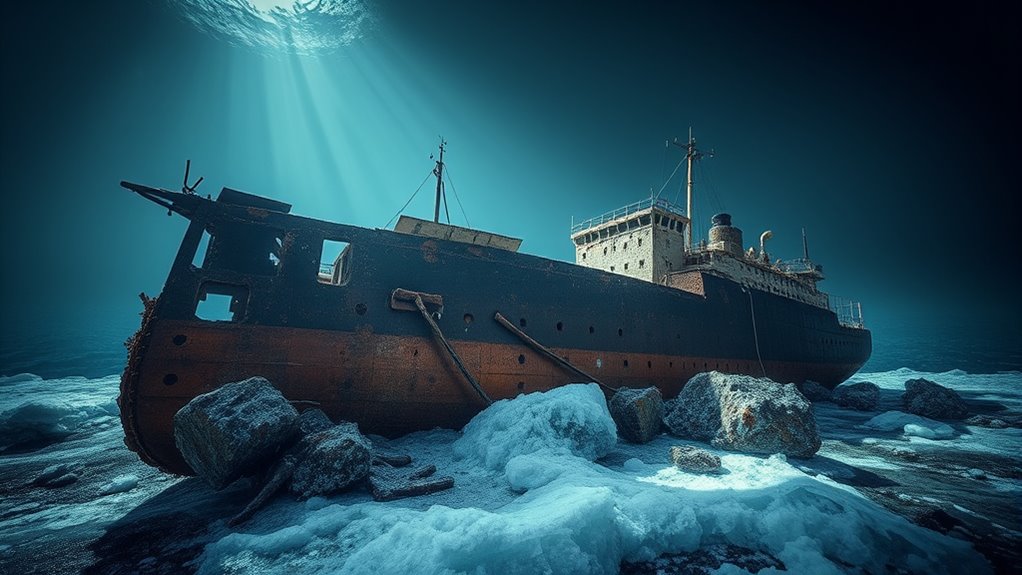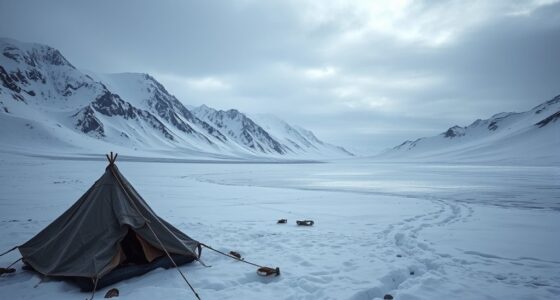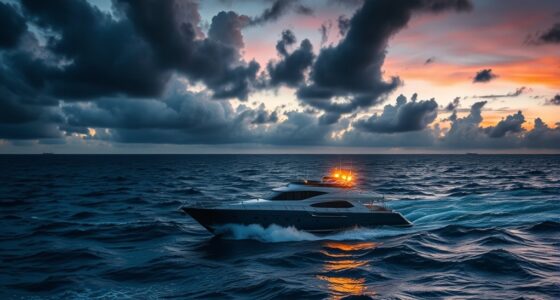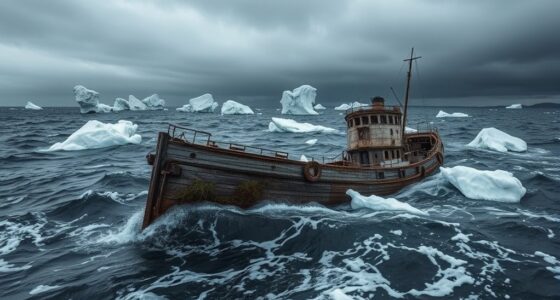Using advanced sonar technology and remotely operated submarines, explorers finally located Shackleton’s Endurance beneath the treacherous ice of the Weddell Sea. The ship’s discovery overcame long-standing navigation errors and unpredictable ice conditions that initially trapped and crushed it. Modern tools allowed searchers to navigate icy waters and uncover the wreck, confirming many theories about its resting place. If you want to learn more about this remarkable story, there’s fascinating detail waiting for you ahead.
Key Takeaways
- Modern navigation technology such as sonar and remotely operated submarines enabled precise location of the wreck.
- The treacherous ice conditions in the Weddell Sea made traditional search methods difficult and risky.
- Advanced exploration tools helped overcome past navigation errors and locate the ship beneath thick ice.
- The discovery confirmed the ship’s final resting place, providing closure to the historic expedition.
- The successful find highlights technological advancements that revolutionized polar exploration and shipwreck discovery.
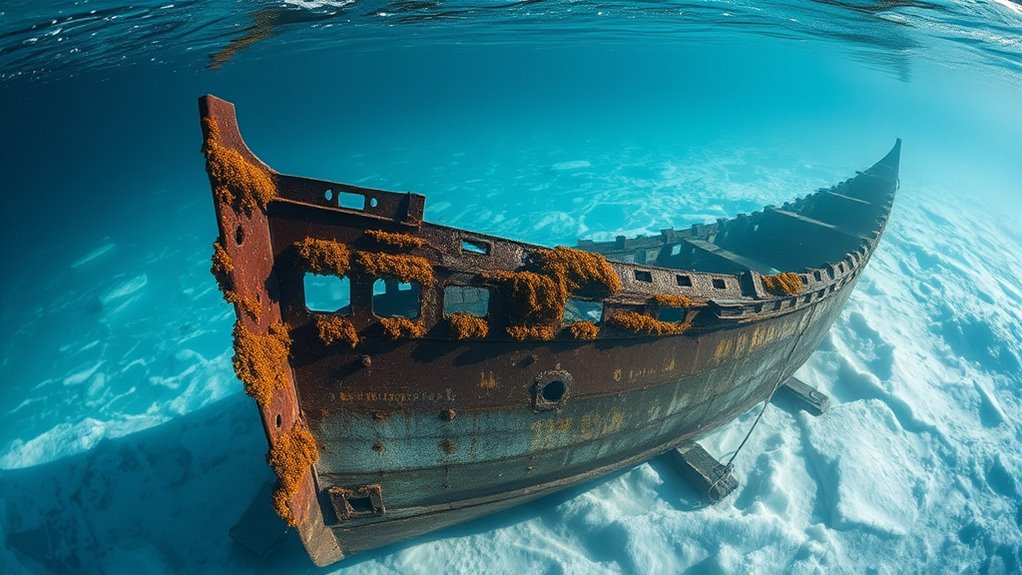
When Sir Ernest Shackleton set out on his ill-fated expedition in 1914, he aimed to cross Antarctica but soon faced unforeseen challenges. The ship, the Endurance, became trapped in relentless pack ice, a brutal obstacle that would seal its fate. As you follow this story, you realize how treacherous ice conditions can be, especially in the unpredictable polar environment. The ice’s shifting nature made navigation incredibly difficult, and despite Shackleton’s careful planning, errors in navigation compounded the problem. These navigation errors, combined with the unpredictable ice movement, led the crew into a perilous situation. The ship was caught in a trap of thick, pressing ice that slowly crushed it, leaving the crew stranded in one of the most remote parts of the world.
You see how the environment played a critical role in the Endurance’s sinking. The ice conditions in the Weddell Sea are notoriously difficult to predict, and even the most experienced explorers can misjudge their strength and flow. Shackleton’s team faced a relentless, shifting maze of ice that closed in around the vessel. Despite their efforts to maneuver, the ship’s position became increasingly precarious. The crew’s navigation errors, perhaps stemming from miscalculations or the challenging ice conditions, contributed to their inability to escape. As the ship became immobilized, the crew knew they faced a battle against nature, not just the ice but also the dangers of exposure and dwindling supplies. Additionally, modern advancements in navigation technology have significantly improved the ability to locate such wrecks, overcoming the challenges faced by early explorers.
Once trapped, Shackleton’s leadership was tested, but the story doesn’t end with the ship’s destruction. Many years later, adventurers and explorers sought to uncover the wreck. The search for the Endurance was complicated by the same treacherous ice conditions that had doomed it decades earlier. Modern technology, like sonar and remote-operated submarines, helped locate the wreck beneath the icy waters of the Weddell Sea. The discovery was a tribute to advancements in navigation and exploration tools, which overcame the historical navigation errors and unpredictable ice flows Shackleton and his crew faced. When the wreck was finally found, it confirmed many of the theories about its final resting place, offering closure to one of the most remarkable stories of survival and exploration in polar history.
Frequently Asked Questions
What Was the Exact Cause of Endurance’s Sinking?
You might wonder what caused Endurance to sink. It was primarily due to an iceberg collision that resulted in a hull breach. The ship got trapped in pack ice, and the pressure from the ice tore the hull open, leading to water flooding in. This damage made it impossible for the ship to stay afloat, ultimately causing its sinking in the icy waters of the Weddell Sea.
How Long Was the Ship Lost Before Its Discovery?
Imagine a ship lost in the icy, endless Antarctic wilderness, frozen in time for over a century. You’d think it vanished into the icy depths forever after its iceberg collision during Antarctic exploration. In reality, the Endurance was lost for about 107 years before explorers finally found its wreck in 2022. That’s like waiting a lifetime plus a few extra years to see a ghostly relic emerge from the icy abyss.
Who Led the Expedition That Found the Wreck?
You might wonder who led the expedition that found the wreck. The search team was led by Dr. rang Eric Bear. His leadership in expedition leadership and his team’s dedication were vital in locating the ship. They used advanced technology and meticulous planning during the search team’s efforts. Thanks to their perseverance, the wreck was finally discovered, shedding light on a historic Antarctic expedition and honoring Shackleton’s enduring legacy.
What Technological Methods Were Used to Locate Endurance?
Imagine you’re a digital detective unraveling a buried secret. You rely on advanced tools like sonar imaging, which paints a ghostly picture of the ocean floor, and underwater drones that glide silently, like underwater spies. These technologies work together to track the elusive wreck of Endurance, piercing through the darkness to reveal its hidden resting place. It’s a high-tech treasure hunt, where innovation leads you straight to history’s deepest secrets.
What Is the Current Condition of the Wreck?
You see that the wreck’s current condition reflects careful historic preservation and underwater archaeology efforts. The ship remains remarkably intact, with much of its structure preserved despite decades underwater. Researchers regularly monitor and document its state to prevent deterioration. Thanks to advanced technology and conservation techniques, the Endurance continues to be a valuable underwater archaeological site, offering insights into its history while ensuring its preservation for future generations.
Conclusion
So, after all that drama, you’d think finding the Endurance was a miracle or maybe just luck. Nope, turns out it was a masterclass in patience, tech, and a dash of obsession. Now you can rest easy knowing that even in the harshest icy graveyard, persistence pays off—because who needs warm beaches when you’ve got underwater robots and a crazy explorer’s dream? Cheers to wrecks finally found, and to never giving up, even when everyone else would’ve quit.
